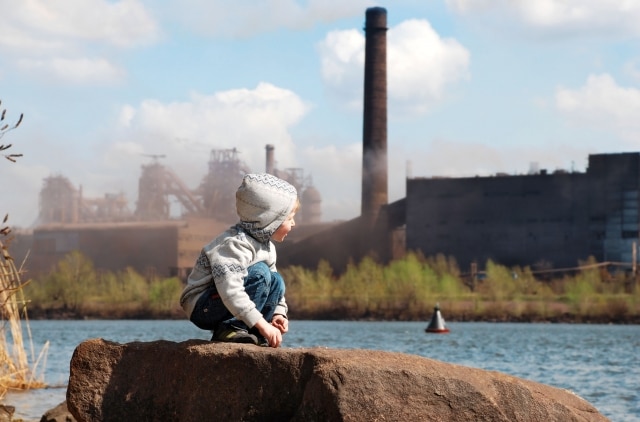In 1998, representatives from a number of fossil fuel companies and industry front groups, led by the American Petroleum Institute, gathered to craft a plan to undermine the American public’s understanding of climate science, and submarine any chances of the United States ratifying the Kyoto Protocol.
Weeks after the private meeting, an eight page memo including a draft “Global Climate Science Communications Action Plan” was leaked and reported by The New York Times, exposing the group’s plan to create public doubt about climate science.
When contacted at the time, industry representatives who were in the room claimed that the plan was “very, very tentative,” and emphasized that none of the groups represented at the meeting had officially agreed to do or fund anything further.
And over the years, whenever members of the then-called “Global Climate Science Communications Team” were asked about the plan, they have repeated that the plan was long ago abandoned.
Yet, as fellow DeSmogBlog contributor Graham Readfearn explained today in a must-read article in The Guardian, practically every key element of the “Global Climate Science Communications Action Plan,” as laid out in the leaked 1998 memo, was executed in some form in the years following the meeting.
Using research from the Climate Investigations Center and DeSmogBlog, Readfearn follows up on all of the plan’s stated goals, strategies, and tactics. You can find an annotated version of the 1998 memo, with “then and now” updates on the careers of the team, on Document Cloud.
Peddling Global Warming Doubt to School Children
A key strategy laid out in the 1998 memo was to target teachers and students, to foment doubt in the classroom and in the minds of a younger generation. The plan stated plainly that “informing teacher/students about uncertainties in climate science will begin to erect a barrier against further efforts to impose Kyoto-like measures in the future.”
Here is an excerpt from a section titled, “National Direct Outreach and Education,” with educational elements in bold.
III. National Direct Outreach and Education: Develop and implement a direct outreach program to inform and educate members of Congress, state officials, industry leadership, and school teachers/students about uncertainties in climate science. This strategy will enable Congress, state officials and industry leaders will be able to raise such serious questions about the Kyoto treaty’s scientific underpinnings that American policy-makers not only will refuse to endorse it, they will seek to prevent progress toward implementation at the Buenos Aires meeting in November or through other ways. Informing teachers/students about uncertainties in climate science will begin to erect a barrier against further efforts to impose Kyoto-like measures in the future.
Tactic: Informing and educating members of Congress, state officials and industry leaders will be undertaken as soon as the plan is approved, funding is obtained. and the necessary resources are arrayed and will continue through Buenos Aires and for the foreseeable future. The teachers/ students outreach program will be developed and funder in early 1999. In all cases, tactical implementation will be fully integrated with other elements of this action plan.
- Organize under the GCSDC a “Science Education Task Group” that will serve as the point of outreach to the National Science Teachers Association (NSTA) and other influential science education organizations. Work with NSTA to develop school materials that present a credible, balanced picture of climate science for use in classrooms nationwide.
- Distribute educational materials directly to schools and through grassroots organizations of climate science partners (companies, organizations that participate in this effort).
Among the metrics listed to track progress of this element of the action plan was:
- Number of school teachers / students reached with our information on climate science.
Though members of the Global Climate Science Communications Team have since denied implementing any elements of this plan, their fingerprints can be spotted on a number of campaigns, projects, and partnerships that emerged in the years after these secret meetings.
Delivering Climate Denial to the Classroom
In 1998, the American Forest Foundation hired a project manager and educational consultant named Rebecca Dobbins to develop and manage Project Learning Tree’s “Energy & Society” program, including a K-8 multimedia energy education kit “to raise awareness about the integral role energy plays in our lives.”
A graphic Project Learning Tree’s “Energy & Society” program.
According to Dobbins’ LinkedIn profile, this program was funded by the American Petroleum Institute, and had a $1 million budget.
In 2004, Dobbins left the American Forest Foundation to work for the American Petroleum Institute itself, developing and managing K-12 “energy education classroom outreach programs and an award-winning educational website, Classroom-Energy.org.
Classroom-Energy.org also promotes the same Energy & Society curriculum kit developed by American Forest Foundation’s Project Learning Tree with API’s funds.
A sample interactive “lesson” from Classroom-Energy.org.
Classroom-Energy.org makes only one passing reference to climate change: “As a greenhouse gas, the carbon dioxide released in the combustion of fossil fuels traps infrared radiation from the earth that would otherwise radiate out to space. This effect is believed to raise the heat of the earth’s atmosphere.”
Promoting The Merits of Fossil Fuels
As part of the Classroom-Energy.org project, API supported the Boy Scouts of America’s Energy Merit Badge. To “support” the scouts, API created a specific microsite within Classroom-Energy.org, including all of the requirements for scouts to earn the merit badge, and offering their own educational resources to help scouts better understand energy issues like, “Where Would We Be Without Oil and Natural Gas?”
The Boy Scouts of America claim no current partnership with API, and DeSmogBlog was unable to find anyone at the organization to confirm any official partnership historically.
The “Earn Your Energy Merit Badge” microsite appears to the general viewer to be officially affiliated with the Boy Scouts of America. Yet while the site instructs scouts to get the official Boy Scouts of America “Energy merit badge book,” it also directs them to consult another API-created site, AdventuresInEnergy.org, to fulfill their research and energy training.
AdventuresInEnergy.org provides scouts with an “interactive look at oil and natural gas,” with no information about any other energy sources.
Oil Industry Partnered with the National Science Teachers Association
The National Science Teachers Association has over 50,000 members, representing all aspects of science education in public and private schools. Until 2001, according to Gerald Wheeler, former Executive Director of NSTA, the association had a partnership with API, under which NSTA produced an energy usage simulation for educational purposes. In 2006, the association was criticized by Laurie David for refusing to distribute 50,000 copies of An Inconvenient Truth to its members. In the same Washington Post op-ed, David accused the NSTA of distributing a video produced by API called “You Can’t Be Cool Without Fuel.”
Wheeler firmly refuted the latter accusation, saying that the association had never had any involvement at all with the oil and gas-promoting video.
While the partnership with API is murky, the NSTA also has a longstanding partnership with Exxon Mobil, which gave the association roughly $6 million from 1996 to 2006 to sponsor the “Building a Presence for Science” program, which creates points of contact for science education in 40,000 schools. Wheeler said outright that “Not once has ExxonMobil asked to use this network for their own purposes.”
Parents and teachers could still be left wondering what educational omissions $6 million could buy Exxon Mobil.
In 1997, a year before the 1998 meetings, Global Climate Science Communications Team member Jeffrey Salmon founded the Environmental Literacy Council (ELC) which aimed to help “teachers, students, policymakers, and the public find cross-disciplinary resources on the environment”.
The ELC went on to co-publish a number of school science books with the NSTA.
Stossel in the Classroom an API deliverable?
One tactic suggested in the 1998 plan was to “convince one of the major news national TV journalists (e.g., John Stossel) to produce a report examining the scientific underpinnings of the Kyoto treaty.”
As Readfearn’s investigation revealed that the staunch libertarian Stossel delivered, not only on the air, but as an added bonus in the classroom.
Working for ABC News and now Fox Business, Stossel has produced a number of segments attacking the climate science consensus. In 2009, for instance, Stossel used an ABC News appearance to question the link between greenhouse gas emissions and rising global temperatures.
This 9-minute segment didn’t just run on the air, but was packaged into the host’s “Stossel in the Classroom” educational materials, distributed to schools along with DVDs and teachers guides.
As Media Matters revealed, “Stossel in the Classroom” has been funded to the tune of over $500,000 by Donors Trust and Donors Capital Fund. These dark money organizations funnel money from various conservative foundations to organizations like the Center for Independent Thought, which distributes “Stossel in the Classroom.”
The Stossel in the Classroom program was launched in 1999, just one year after the Global Climate Science Communications Plan was hatched.
Students less suckered than politicians
Outreach to teachers and students and classroom interventions actually made up a relatively small part of the entirety of the Global Climate Science Communications Plan. Though participants in the 1998 meetings still claim that the plan was long abandoned, as Readfearn explains, many programs have emerged over the past 17 years that fit the goals, strategies, and descriptions laid out in the draft plan.
And in most cases, the groups running these programs had representatives in the room the day the plan was hatched, or are closely connected to the Global Climate Science Communications Team.
Despite the ongoing denials, the evidence is clear that the plan was executed in varying degrees by those who were in the room in April 1998.
As Kert Davies of the Climate Investigations Center told The Guardian, ”Impacting the voice of elected officials was a key target under the ‘Victory will be achieved’ section of the memo. Now in the US, about half our elected officials are climate deniers or are scared to even talk about the subject, so the impact of this 1998 campaign and subsequent misinformation campaigns around climate science is still clearly holding us back from climate policy solutions.”
It’s still early to tell if the outreach to America’s youth has proven anywhere near as effective. But recent polling has provided some hope, as well over half of American voters aged 18 to 34 believe that “Climate change is a severe threat that we must start addressing now,” and fewer than one-third believe that humans have no impact on global warming.”
Read the full 1998 Global Climate Science Communications Plan with annotated examples of evidence that the plan was implemented:
Image credit: Boy playing in front of plant via Shutterstock.
Subscribe to our newsletter
Stay up to date with DeSmog news and alerts








